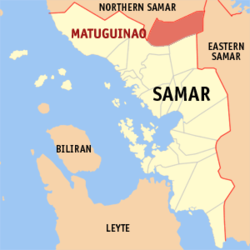Matuguinao | |
|---|---|
| Municipality of Matuguinao | |
 Forest in Matuguinao | |
 Map of Samar with Matuguinao highlighted | |
Location within the Philippines | |
| Coordinates: 12°09′N124°53′E / 12.15°N 124.88°E | |
| Country | Philippines |
| Region | Eastern Visayas |
| Province | Samar |
| District | 1st district |
| Founded | June 19, 1965 |
| Barangays | 20 (see Barangays) |
| Government | |
| • Type | Sangguniang Bayan |
| • Mayor | Aran D. Boller |
| • Vice Mayor | Cleofe D. Belonio |
| • Representative | Stephen James Tan |
| • Councilors | List |
| • Electorate | 6,241 voters (2025) |
| Area | |
• Total | 172.51 km2 (66.61 sq mi) |
| Elevation | 188 m (617 ft) |
| Highest elevation | 754 m (2,474 ft) |
| Lowest elevation | 14 m (46 ft) |
| Population (2024 census) [3] | |
• Total | 7,708 |
| • Density | 45/km2 (120/sq mi) |
| • Households | 1,545 |
| Economy | |
| • Income class | 5th municipal income class |
| • Poverty incidence | 42.56 |
| • Revenue | ₱ 125.2 million (2022) |
| • Assets | ₱ 288.6 million (2022) |
| • Expenditure | ₱ 108.2 million (2022) |
| • Liabilities | ₱ 150.4 million (2022) |
| Service provider | |
| • Electricity | Samar 1 Electric Cooperative (SAMELCO 1) |
| Time zone | UTC+8 (PST) |
| ZIP code | 6708 |
| PSGC | |
| IDD : area code | +63 (0)55 |
| Native languages | Waray Tagalog |
Matuguinao, officially the Municipality of Matuguinao (Waray : Bungto han Matuguinao; Tagalog : Bayan ng Matuguinao), is a municipality in the province of Samar, Philippines. According to the 2020 census, it has a population of 7,364 people, making it the least populated municipality in the province. [5]



